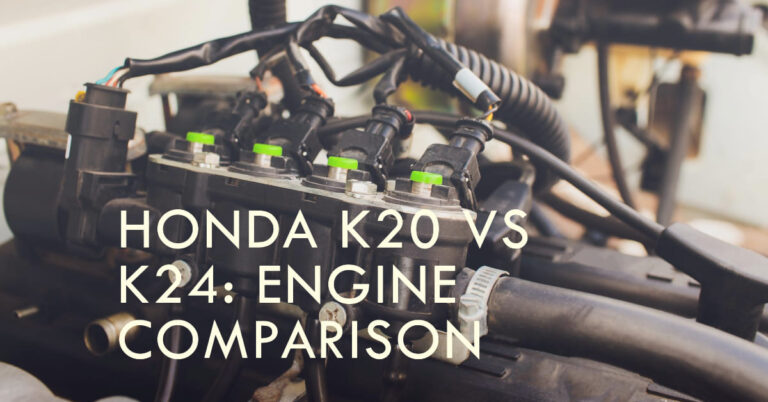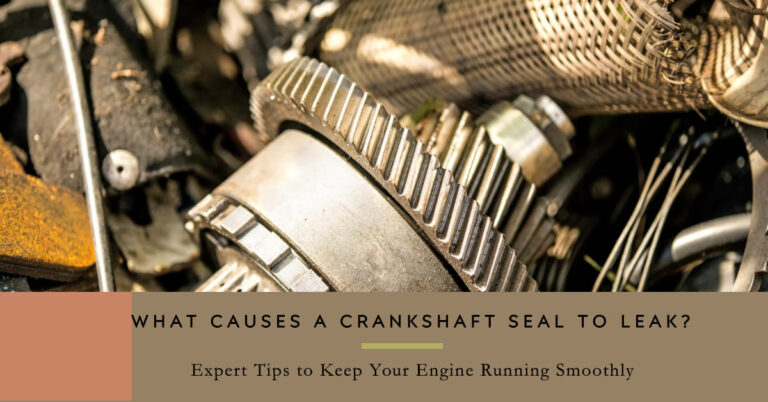Oil On Spark Plug Threads Or Wells? Here’s Why And How To Fix?

Have you ever pulled out your spark plugs only to find them covered in oil? Discovering engine oil on the ceramic insulator or threaded end of spark plugs is perplexing for many gearheads and backyard mechanics. Your initial reaction may be to scratch your head wondering how on earth oil made its way into the combustion chamber.
Rest assured, you’re not alone in pondering this confounding automotive phenomenon. Oil on spark plugs is actually quite common on high mileage, worn engines. But is it necessarily detrimental? What causes oil to foul or coat spark plugs and should you be concerned? And more importantly, how can you thoroughly diagnose the root cause and fix the issue?
In this comprehensive spark plug oil fouling guide, we’ll cover all the nitty-gritty details including:
- Common causes of oil on spark plug threads, tips, and insulators
- The potentially damaging effects oil can have on plug performance
- How to properly diagnose if plug fouling points to a larger engine issue
- Effective cleaning processes and removal techniques
- When oil contaminated spark plugs need replacement
- Pro tips for repairing the root causes of oil fouling
So if you’ve pulled oil-soaked spark plugs from your engine, read on for an in-depth look at why it happens, how bad the oil contamination is, and most crucially, how to fix the problem for good!
Table of Contents
What Causes Oil On Spark Plugs?
Before diving into the ramifications of spark plug oil fouling, it helps to understand the most prevalent causes. There are a few ways engine oil can end up on the ceramic insulator tip and threaded housing of your spark plugs:
Worn Valve Guide Seals
On overhead cam engines, the valve guide seal’s job is to control oil within the cylinder head and keep it from leaking down into the combustion chamber. But over time, these rubber seals can harden and shrink, allowing oil to be pushed past into the chamber and onto the spark plugs.
If you find oil on only one or a couple plugs, deteriorated valve guide seals specific to those cylinders are likely the culprit. Replacing them should solve isolated oil fouling issues.
Excessive Oil Blow-By
Blow-by occurs when combustion gases and vaporized oil leaks past worn piston rings or cylinder walls into the crankcase. Excessive blow-by pressurizes the oily crankcase vapors, pushing them up into the cylinder and down the spark plug wells.
Too much blow-by due to high mileage engines with tired rings and cylinders can quickly foul all spark plugs with oil residue.
Low Valve Spring Tension
The springs encircling the valve stems keep tension against the retainers and prevent valves from rattling around. Weak or broken valve springs with insufficient tension can allow valves to slightly drift when closed, enabling oil to seep through and coat spark plugs.
Overfilled Oil
Simply putting too much oil into your crankcase can cause oil fouling issues. Overfilling above the “Full” mark allows moving components to churn and whip the oil into an oily mist that works its way up the plug wells.
Sticking to your manufacturer’s oil capacity spec and regularly checking levels can avoid this fouling factor.
Changing Spark Plugs
Here’s one you may not expect – the very act of changing your spark plugs can actually cause oil to end up in the threaded wells! How? Well, each time a plug is removed, residual oil from the cylinder head drain down into the open chamber and threads.
Once the new plugs are installed, this residual oil transfer can make it seem as though the fresh plugs are already oil fouled. Not to worry though, this impact is minimal and often evaporates after getting the engine up to temp.
While these are the most common sources of spark plug oil fouling, any engine oil leaks can potentially contribute. Crankcase leaks, oil pan leaks, damaged breather tubes, and even very worn piston oil rings can allow oil to seep into the combustion area and coat spark plugs.
Is Oil On Spark Plugs Bad? Potential Damage
Now that you know where the oil contamination comes from, let’s discuss the ways oil can negatively impact spark plug and overall engine performance.
1. Reduced Spark and Misfires
The number one consequence of excess oil on plugs is the effect it has on their ability to fire and spark properly. Oil residue coats the ceramic insulator tip meant to prevent spark from grounding.
The conductive oil allows the spark energy to leak to ground instead of firing across the gap. This causes weak sparks, intermittent misfires, and overall reduced ignition performance. Misfires from oil fouled plugs can make the engine run rough, lack power, and decrease fuel economy.
2. Carbon and Ash Buildup
As oil deposits collect on the plugs over time, they attract carbon and combustion byproducts. This carbon and ash buildup provides an additional conductive path for spark energy to escape to ground. This exacerbates the misfires, roughness, and weak performance caused by the oil alone.
The combination of oil and carbon fouling on spark plugs can accelerate wear and significantly inhibit the plug from operating as designed.
3. Corroded and Damaged Plugs
Besides carbon buildup, oil contamination also opens the door for spark plug corrosion. As engine oil ash accumulates on the plugs from blow-by gasses, the contaminants interact with the metal surfaces.
Corrosion damage and rust erosion begin to form on the threads, electrodes, and metal casing from chronic oil fouling. This can rot and eat away at the plug components, eventually causing irreversible structural damage.
4. Premature Plug Failure
For all the reasons above, oil fouled spark plugs tend to fail and require replacement much sooner than non-fouled plugs that fire properly. Considerably cutting down the typical plug life adds more frequent maintenance.
While an occasional light coat of oil on plugs is not dire, chronic heavy oil fouling can indeed be damaging. But with effective cleaning or replacement, the degraded spark and engine performance can be restored.
Diagnosing Oil Fouling – Is it a Spark Plug Issue or Engine Issue?
If you discover excessive oil residue on your spark plugs, the next step is properly diagnosing where the fouling stems from. Is oil simply coating the plugs themselves or does it indicate a larger internal engine issue?
Here are a few key ways to determine the root cause and ensure spark plug fouling is not a warning sign of greater problems within the engine:
Inspect All Plugs and Note Patterns
Carefully remove each spark plug and examine the contact point ceramic and threaded housing. Note any patterns – are all the plugs fouled evenly? Or is it isolated to just one or a couple plugs showing higher oil residue?
Random oil wetness on all plugs likely means excessive blow-by distributing oil throughout the cylinders. But if the fouling is concentrated on only 1 or 2 plugs, worn valve guide seals letting oil reach the plugs is more probable.
Analyzing the oil fouling patterns can isolate the root cause.
Check Plug Color for Source
Take a close look at each oil fouled spark plug removed from the engine and identify the color of the oil residue:
- Tan or brownish coating – Indicates normal engine oil blowing by rings/seals
- Thick black deposits – Suggests oil burning and carbon accumulation
- White powder residue – Points to corrosion from oil contamination
- Coolant staining – Signals a cylinder head gasket leak
The color and texture of the oil fouling provide clues into exactly what’s coating the plugs.
Monitor Engine Misfires
Use your OBDII scanner tool to watch for any misfires detected as you rev the engine. Oil fouled spark plugs that are unable to fire properly will trigger your engine computer to log misfires.
Pay attention which cylinder(s) record the most misfires as it can isolate the problem to specific bad plugs or worn valve seals.
Compression Test
Low cylinder compression enables more blow-by allowing oil to leak past the rings. Conducting a compression test on each cylinder can identify if worn piston rings are the culprit.
Dramatically lower compression on all cylinders points to worn piston rings and excessive blow-by pressurizing oil into the chambers. Whereas uniform compression affirms rings are likely not the source.
By combining visual plug inspections, misfire data, compression testing, and analyzing oil colors, you can zero in on the root cause and best remedy for eliminating oil fouling issues.
Fixing Oil Saturated Spark Plugs – Clean or Replace?
Once you’ve diagnosed oil fouled spark plugs and determined the leading cause, it’s time to take action. But should you clean the oil contaminated plugs or just replace them with new ones? Let’s compare the two options.
Cleaning Oil Fouled Plugs
Cleaning oil fouled yet undamaged spark plugs is possible in many cases. Here’s how:
- Use brake cleaner spray and a wire brush to carefully remove excess debris and oil from the ceramic insulator tip and electrodes. Avoid damaging the surfaces.
- Rinse the plugs with additional brake or carb cleaner then allow to fully dry.
- Run the plug threads through a thread chaser tap to thoroughly clean out any residual oil from the threaded housing.
- Check and reset the spark plug gap as needed.
- Reinstall the cleaned, oil-free plugs with fresh gaskets.
With mild to moderate oil fouling, this restoration process can remove contamination and restore optimal performance. It’s an affordable fix saving the cost of new plug replacements.
Caution: Severely corroded or structurally damaged plugs cannot be sufficiently cleaned. Replacement is necessary in those cases.
Replacing Oil Soaked Spark Plugs
If the oil fouled plugs are too far gone, or cleaning efforts do not fully restore operation, replacing them is required.
Install a new set of factory recommended spark plugs with the proper heat range for your vehicle. Use anti-seize lubricant on the threads before torqueing to spec for ease of future removal.
While replacing plugs adds parts cost, it ensures maximized ignition performance. Consider it an investment toward preventing continued misfires and future engine damage.
As you choose between cleaning or replacing oil fouled plugs, general guidelines are:
- Light Oil Fouling – Cleaning appropriate
- Moderate Fouling – Try Cleaning but monitor performance
- Heavy Fouling – Replacement recommended
An immediate plug change is advised for any plug damaged beyond cleaning or extremely oil soaked. But for light to moderate fouling, attempt cleaning first and replace later if needed.
Now let’s discuss repairing the root causes so oil fouling stops reoccurring after the plug service.
Repairing Root Causes of Oil Fouling
Once the fouled plugs themselves are addressed, fixing the underlying root cause of oil leaks is equally crucial. Otherwise, the fresh cleaned or new plugs will eventually become oil contaminated again.
Here are tips targeting the common sources:
Worn Valve Seals
Diagnose which cylinder’s valve guide seals are worn using the plug fouling patterns. Replace just those specific seals causing leaks rather than the entire set. Use factory spec parts. Adjusting valve lash can also tighten seals.
Excessive Blow-By
Piston rings and cylinder walls wear overtime, allowing blow-by pressurizing oil into the chambers. A full ring job and cylinder honing is the permanent solution, but expensive. Try running thicker oil like high mileage formulas to slow leaks past rings. Limit high RPMs and spirited driving which worsens blow-by.
Weak Valve Springs
Inspect valve springs for cracked or stretched coils that indicate fatigue. Replace any bad springs and verify spring height and valve lash are in spec.
Overfilled Oil
Sticking to the factory fill quantity on the dipstick prevents churning and oil fouling. Inspect for leaks causing low oil that then gets overfilled. Fix any leaks and maintain proper oil level.
Any repairs that stop oil from leaking into the combustion chamber will prevent ongoing oil fouling after plug service. The key is not only addressing the spark plugs, but also taking actions to fix the root internal causes.
Intermittent Oil Fouling Spark Plug Maintenance
To maximize longevity for healthy plugs and minimize future oil fouling, consider adding spark plug service to your regular engine maintenance routine.
- Inspect plugs every tune-up or 20K miles. Look for oil wetness starting early before fouling gets severe.
- Clean Plugs at 100K miles or if fouling just starting. Use cleaning methods above.
- Replace Plugs at manufacturer’s recommended replacement intervals, usually around 100K miles.
- Replace Boots and Wires with new plugs if cracked or damaged. Use dielectric grease inside the boots to prevent oil wicking up the wires.
- Rethread Wells with a tap and use anti-seize on plug threads to make future removal easier if fouling recurs.
By routinely checking and servicing your spark plugs as part of standard maintenance, you can stop oil fouling in its tracks before it causes misfires or damage. Think of it as inexpensive engine insurance!
The Bottom Line on Spark Plug Oil Fouling
Oil fouled spark plugs are unavoidable as engines rack up the miles. But as we’ve covered, it doesn’t have to spell disaster or ruin performance.
- Understand what causes oil on plugs and where it’s coming from
- Diagnose if plug fouling points to larger internal issues
- Clean or replace plugs based on severity of contamination
- Repair root causes like worn seals, rings, cylinders
- Do preventive plug maintenance to maximize longevity
While oil on spark plugs might seem alarming initially, arming yourself with the facts helps overcome the fear factor. In most cases, you can get to the bottom of the oil fouling mystery through methodical diagnosis. Then remedy it with a combination of strategic spark plug servicing and fixing underlying wear.
So next time you peer into your engine and spot those grimy black or brown deposits on your precious plugs, don’t fret. Now you’re equipped with the knowledge and action plan to banish oil fouling for good and keep your ignition firing on all cylinders. Diagnose, treat, maintain, and drive on with confidence!
Conclusion
Oil fouled spark plugs are a common nuisance on high mileage engines, but not a death sentence. This article provided a comprehensive guide on identifying the root causes, understanding the potential impacts, and detailing proven cleaning and replacement remedies. Most importantly, fixing worn components allowing oil to leak past in the first place is crucial to prevent recurrence. With routine plug inspection and maintenance, oil fouling can be minimized to keep your ignition system running optimally for the long haul!






